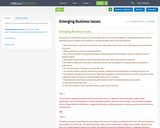
Using a current event topic prepare a pro and con argument.
- Subject:
- Business and Information Technology
- Career and Technical Education
- Material Type:
- Formative Assessment
- Date Added:
- 04/25/2019

Using a current event topic prepare a pro and con argument.
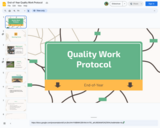
This road trip-themed presentation can be used to guide the Quality Work protocol by EL Education at the end of the school year. Using the protocol will enable students to review student work and reflect on their students' ability to create complex and authentic work and demonstrate craftsmanship as described in EL Education's Three Dimensions of Student Achievement. Teams can also use this process to guide their continuous improvement efforts.
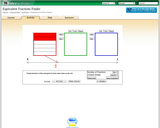
Visually represent two unique fractions that are equivalent to a given fraction. The fractional value is shown on a number line after you check to see if your fraction is correct. Equivalent Fraction Finder is one of the Interactivate assessment explorers.
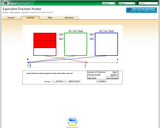
Visually represent two unique fractions that are equivalent to a given fraction. The fractional value is shown on a number line as you color in the fraction. Equivalent Fraction Pointer is one of the Interactivate assessment explorers.
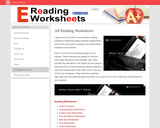
This resource offers ELA teachers over 100 exercises to teach a variety of Common Core lessons. The following are included: reading comprehesion, figurative language, genre, grammar, punctuation, sentence structure, point of view, text structure, and writing. The exercises have standards attached, and often there is a power point to present the lesson. It is also organized by grade level, making use for teachers extremely efficient.
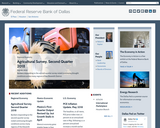
An individual booklet with a interactive whiteboard lesson designed for high school students in the Marketing or Entrepreneurship classroom. Sets of 50 booklets can be ordered for your classroom at no charge. www.dallasfed.org/educate/
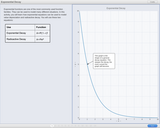
In this activity students learn to use two different equations for modeling real-life situations that involve exponential decay. This is the third of three activities about Exponential Functions. The associated lesson plan and student assessment questions can be found at: https://concord.org/projects/smartgraphs#curriculum and clicking on “Algebra†and then “Exponential Functions.â€Â

Learn how equations for several exponential functions are used to model population growth and compound interest. This is the second of three activities about exponential functions. The associated lesson plan and student assessment questions can be found at: https://concord.org/projects/smartgraphs#curriculum and clicking on “Algebra†and then “Exponential Functions.â€Â

This is an example of how middle school students can demonstrate thier knowledge of the F.I.T.T formula. They can create examples in class and then write them down on a card. The teacher will then collect the cards and distribute to groups on another day and the groups can decide if they activites meet the the F.I.T.T formula and provide feedback to the other groups.
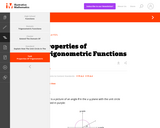
Students are given an arbitray unit circle and then asked the following questions:
Explain why sin(−θ)=−sinθ and cos(−θ)=cosθ. Do these equations hold for any angle θ? Explain.
Explain why sin(2À+θ)=sinθ and cos(2À+θ)=cosθ. Do these equations hold for any angle θ? Explain.
This task can be used as a short formative assessment, and can be done individually, in pairs, or in small group.

This resource includes (1) a guided notetaking handout and (2) an accompanying powerpoint for Ray Bradbury's Fahreheit 451 that guides students in close reading for thematic evidence and analysis.
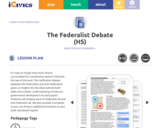
Website Description:
It’s easy to forget how much drama surrounded the Constitution before it became the law of the land. The ratification debate between the Federalists and Anti-Federalists gives us insight into the ideas behind both sides and a better understanding of how our government developed in its early years. Students will analyze parts of Federalist 84 and Anti-Federalist 46. We also provide a template so you can bring in additional excerpts as your state standards require.
Student Learning Objectives:
Students will be able to:
*Identify the arguments used by the Federalists and Anti-Federalists during the ratification debate
*Analyze excerpts from the Federalist Papers (#84) and Anti-Federalist Papers (#46)
*Describe the importance of the Bill of Rights in the ratification debate
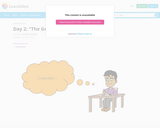
This lesson teaches students to understand figurative language and how it effects meaning. The students will read a nonfiction piece on The Great Chicago Fire. Students can then work with a partner or small group to answer the questions about the figurative language.
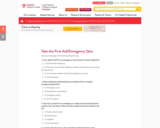
This resource is a quiz posted by Stanford Children's Health that tests students' knowledge of 911 calls and what should constitute them. For an activity, your students should complete the quiz as many times as it takes them to get above an 80%. After completing the quiz come together for a large group discussion and ask the students if they learned anything new or if any of the information surprised them.
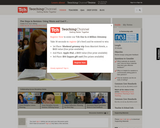
The overview for this lesson is for students to work together in peer review utilizing the strategy of warm and cool feedback based on the sixt traits of writing. After this lesson, students will take the feedback that they have given to each other and revise their essay, specifically revising to show growth on the goals that they made over the course of this lesson.

This is a presentation for the Food Sanitation unit including the guidelines for storing, prepping, handling, and holding food. There is a study guide that goes along with the presentation.
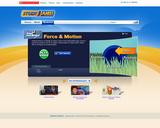
This video introduces the concept of inertia by having students think about how the balls moves in soccer. It explains that anytime there is a change in motion it is due to a force, and inertia is what keeps an object sitting still or moving at a constant speed. There is a summary of the important information at the end, a list of essential vocabulary, and a quiz of the information from the video. This would be a great way to introduce and reinforce a lesson on inertia.
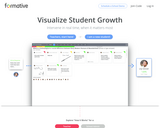
Formative is a formative assessment tool that allows teachers to create assessment for students in which they can type, show their work with drawings or submit images.
It allows teachers to provide frequent formal and informal checks for understanding guarantee student growth as well as know exactly what each student needs as they learn and take immediate actions
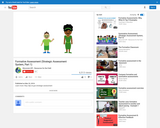
Educators use formative assessment to continually reflect and improve their skills related to these practices. The Formative Assessment video is a resource that can be used to support educators' professional development related to assessment literacy. Use the Video Supplement & Resource Guide to enhance your facilitation of this professional development opportunity.

From the website describing this resource:
With a main purpose of presenting ways that intentional review of student work can be a guide in professional development, Formative Assessment as a Compass, by Beth Rimer and Terri McAvoy, also offers ways for professional development leaders to help teachers plan lessons that fit their classrooms and students. The book starts with a definition of formative assessment and the connection between assessment and student work and goes on to offer strategies for when and how to notice what's going on with students for the purpose of moving them forward as writers.